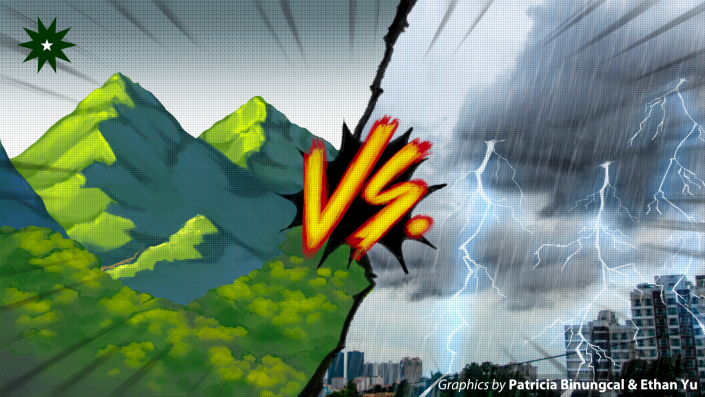With their towering heights and expansive lengths, the Sierra Madre Mountain Ranges (SMMR) and the Cordillera Mountain Ranges (CMR) have long been believed to act as natural barriers to typhoons. Even Philippine mythologies speak of a mother named Sierra, who laid down with her back facing the ocean to protect her children from Bugsong Hangin, the king of the easterlies.
However, this centuries-old notion could be dispelled by new evidence on the true effects of mountain ranges on typhoon hazards. In their 2023 study, Dr. Gerry Bagtasa and Bernard Alan Racoma of the University of the Philippines Institute of Environmental Science and Meteorology addressed the misconceptions surrounding the role that the Luzon mountain ranges play during a typhoon event.
Breaking intuition
The intuitive idea of the immense SMMR or CMR weakening typhoons breaks down as one delves into the details. A simple point Bagtasa brought up is the height of the SMMR. Although the SMMR is the longest mountain range in the country, it is merely one and a half kilometers in vertical height. In contrast, a typhoon can rise up to 15 kilometers or more.
However, this does not mean that the SMMR and the CMR are completely ineffective against typhoons. In fact, Bagtasa believes that height alone is not a reliable indicator because even small structures like a tree or a building can protect someone from a storm. “‘Pag malakas ang ulan [at] malakas ang hangin, you just go to the side of a building and the structure will protect you,” he says. “If that’s the case, we’re not really sure if it’s (Sierra Madre) really a barrier.”
(When the rain is strong and the wind is strong…)
To scientifically measure the effectiveness of the SMMR and CMR, Bagtasa and Racoma analyzed the ranges’ impact on two types of typhoon hazards: the rain and the wind. Their study quantified “wind hazard” by noting it as the accumulated wind field energy (AWE), or the total energy generated by the wind within a tropical cyclone over a specific period. They reported that the SMMR can reduce the AWE by one to 13 percent, whereas the CMR can reduce the AWE in the Cagayan Valley by eight to 30 percent.
However, the effects of the SMMR and the CMR on rainfall are more nuanced. Bagtasa compares the mountain ranges to a funnel that directs rainfall into localized areas like valleys and rivers. The study found that the CMR might not even decrease rainfall at all, as it rather intensifies it in surrounding regions by up to 58 percent. As for the SMMR, its western slopes—the side facing the Pacific Ocean—and the National Capital Region may experience a 23 to 48-percent and 25 to 55-percent increase in rainfall due to the SMMR, respectively. In the Cagayan Valley, on the other hand, the SMMR cuts down rainfall by 10 to 59 percent.
Ultimately, the effects of SMMR and CMR appear to be a trade-off for areas outside the Cagayan Valley, wherein there is essentially more rainfall for less wind hazard. While natural events like rainfall and flooding may be amplified by human activities such as deforestation and mining, Bagtasa explains that they can also be attributed to the geographic reality provided by the mountain ranges.

Letting nature run its course
Although these mountain ranges can reduce wind hazards, they cannot always weaken a typhoon. Bagtasa stresses that immediately jumping to this conclusion can make people complacent during a natural disaster, leading to dangerous repercussions.
He cites as an example Typhoon Odette, which intensified into a super typhoon just before making landfall over Siargao Island in Mindanao in December 2021. Just like Luzon, the eastern coast of Mindanao is also lined with mountains. Contrary to what people expected, the typhoon rapidly intensified as it approached the landmass. The eventual disaster brought widespread havoc throughout the country, with damages being reported as far west as the Pag-asa Island in the West Philippine Sea.
Typhoon Karding, which slammed into Eastern Luzon in September 2022, also underwent a rapid intensification phase, upgrading into a super typhoon category merely 12 hours before making landfall over the Polillo Islands, despite the presence of the SMMR on Luzon’s eastern coast. The tropical cyclone also brought up to 300 millimeters of rain in a span of five days—about half the monthly average—in areas as far as Subic on the western coast of Luzon
Moving forward, Bagtasa argues that a primary course of action would be to just “move away” when a typhoon is forecasted to hit the area. He explains that from what has been a primarily “building barriers against nature” mindset, the narrative should be shifted toward one that understands that nature cannot be fought. “The best thing we can do is to step away, let nature run its course, and then we can go back to our life,” he reckons.
Beyond their roles in amplifying or minimizing typhoon hazards, mountain ranges play host to rich biodiversity which have been consistently under threat from human exploitation. Bagtasa and Racoma assert in their study the importance of this characteristic. “Rather than focusing our conversations on the mountain ranges ‘protecting’ us from the impacts of TCs (tropical cyclones), we should instead shift the discourse to protecting these mountain ranges from anthropogenic impacts,” they conclude.
In the long run, moving beyond minimizing the Sierra Madre and the Cordillera Mountain Ranges as mere typhoon barriers toward understanding their broader ecological implications remains more crucial than ever, opening the door to better environmental protection and even typhoon risk management.
